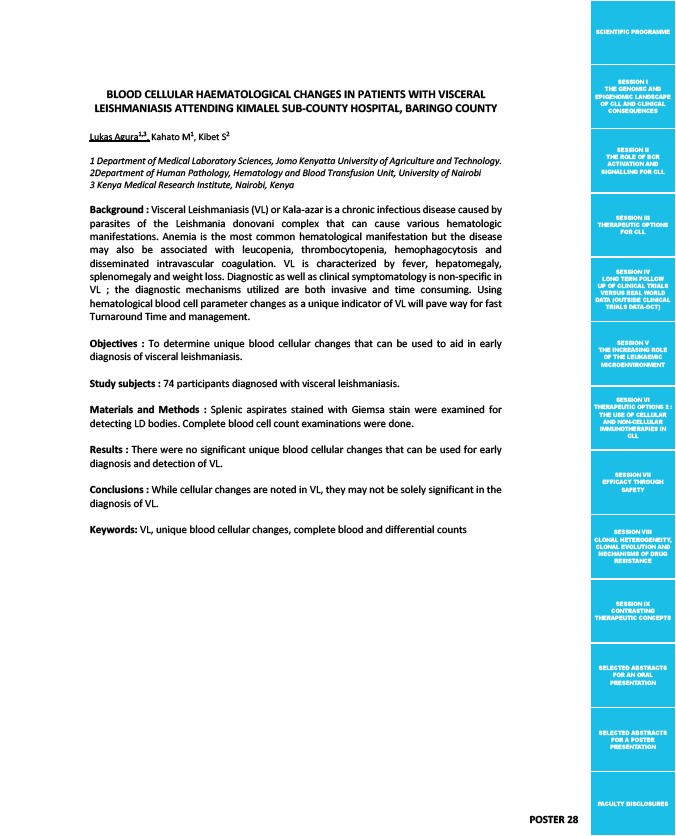
SCIENTIFIC PROGRAMME
SESSION I
THE GENOMIC AND
EPIGENOMIC LANDSCAPE
OF CLL AND CLINICAL
CONSEQUENCES
SESSION II
THE ROLE OF BCR
ACTIVATION AND
SIGNALLING FOR CLL
SESSION III
THERAPEUTIC OPTIONS
FOR CLL
SESSION IV
LONG TERM FOLLOW
UP OF CLINICAL TRIALS
VERSUS REAL WORLD
DATA (OUTSIDE CLINICAL
TRIALS DATA-OCT)
SESSION V
THE INCREASING ROLE
OF THE LEUKAEMIC
MICROENVIRONMENT
SESSION VI
THERAPEUTIC OPTIONS 2 :
THE USE OF CELLULAR
AND NON-CELLULAR
IMMUNOTHERAPIES IN
CLL
SESSION VII
EFFICACY THROUGH
SAFETY
SESSION VIII
CLONAL HETEROGENEITY,
CLONAL EVOLUTION AND
MECHANISMS OF DRUG
RESISTANCE
SESSION IX
CONTRASTING
THERAPEUTIC CONCEPTS
SELECTED ABSTRACTS
FOR AN ORAL
PRESENTATION
SELECTED ABSTRACTS
FOR A POSTER
PRESENTATION
FACULTY DISCLOSURES
BLOOD CELLULAR HAEMATOLOGICAL CHANGES IN PATIENTS WITH VISCERAL
LEISHMANIASIS ATTENDING KIMALEL SUB-COUNTY HOSPITAL, BARINGO COUNTY
Lukas Agura1,3, Kahato M1, Kibet S2
1 Department of Medical Laboratory Sciences, Jomo Kenyatta University of Agriculture and Technology.
2Department of Human Pathology, Hematology and Blood Transfusion Unit, University of Nairobi
3 Kenya Medical Research Institute, Nairobi, Kenya
Background : Visceral Leishmaniasis (VL) or Kala-azar is a chronic infectious disease caused by
parasites of the Leishmania donovani complex that can cause various hematologic
manifestations. Anemia is the most common hematological manifestation but the disease
may also be associated with leucopenia, thrombocytopenia, hemophagocytosis and
disseminated intravascular coagulation. VL is characterized by fever, hepatomegaly,
splenomegaly and weight loss. Diagnostic as well as clinical symptomatology is non-specific in
VL ; the diagnostic mechanisms utilized are both invasive and time consuming. Using
hematological blood cell parameter changes as a unique indicator of VL will pave way for fast
Turnaround Time and management.
Objectives : To determine unique blood cellular changes that can be used to aid in early
diagnosis of visceral leishmaniasis.
Study subjects : 74 participants diagnosed with visceral leishmaniasis.
Materials and Methods : Splenic aspirates stained with Giemsa stain were examined for
detecting LD bodies. Complete blood cell count examinations were done.
Results : There were no significant unique blood cellular changes that can be used for early
diagnosis and detection of VL.
Conclusions : While cellular changes are noted in VL, they may not be solely significant in the
diagnosis of VL.
Keywords: VL, unique blood cellular changes, complete blood and differential counts
POSTER 28